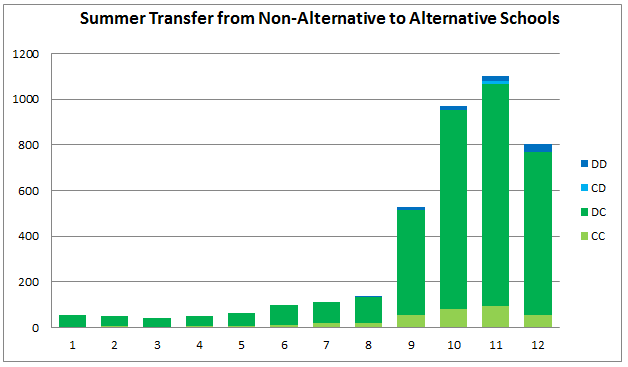By Ildi Laczko-Kerr and Eileen Sigmund
A common myth is that alternative schools serve as a “last resort” for at-risk students or as a means to re-entry into school for students who have dropped out and are under-credited and over-aged. Recent data demonstrate that in fact, many students are choosing to enroll in alternative schools before ever stepping foot on a traditional high school campus.
An alarming percentage of students are leaving their non-alternative district school and choosing to attend an alternative charter school, beginning in ninth grade. These students are either self-identified as at-risk, or designated as such by their district school. However, they are not drop-outs because 1) nearly all were promoted from grade 8; and 2) they have not started their high school classes so they are not under-credited or credit deficient. In other words, alternative charter schools are casting a much wider safety-net for Arizona’s academically struggling students than previously thought.
What is a Public Alternative School?
Alternative schools are public schools whose sole and clearly-stated mission is to serve specific populations of at-risk students. Alternative schools positively impact students’ reengagement; the result is an overall benefit to the state in terms of economic and educational outcomes. To be classified as “alternative,” schools must meet an Arizona State Board of Education approved definition and are required to be certified annually through student enrollment audits. In the 2017-18 year, 73 percent of all alternative schools were charter schools. Approximately 20 percent of Arizona’s 556 charter schools were alternative schools.
What data was used in this study?
In a new study from the Center for Student Achievement, an LLC of the Arizona Charter Schools Association, state-wide summer transfer patterns and student achievement data were analyzed. The first report busted the myth that charters “creamed” district students by enrolling primarily high performing students. The question of choice for at-risk students emerged given the high percentage of transfer students between traditional and alternative schools. To be included in this study, students changed local education agencies between the 2014-2015 and 2015-2016 school years before they reached the end or final grade in their public district or public charter school. The data set included grades K-12 for all public district and charter schools, including alternative schools.
How many students were involved in the study?
More than 4,000 students completed the 2014-2015 school year in a non-alternative school and enrolled in an alternative charter school in 2015-2016. These data were analyzed using the same four distinct “migration patterns” as the larger study.
How do we know alternative schools are a choice for students?
The transfer of students to alternative school settings from non-alternative settings demonstrates a significant movement between districts to charters; overall 89 percent of the movement to alternative schools comes from traditional districts. In ninth grade, 87 percent of the students transferring to alternative schools came from a non-alternative district setting, as well as 90 percent in grade 10, and 88 percent in grades 11 and 12.
The positive impact of alternative schools
This view of alternative school enrollment casts a significant and new light on our understanding of at-risk students, their choices and (1)the positive impact alternative schools have on the state. Additionally, it provides further evidence that public charter schools don’t “cream” students; instead, they are fulfilling their statutory mandates to improve student achievement and provide choice.
[1] In 2014, the Arizona Mayors’ Roundtable did a report on high school dropouts. For the 18,000 Arizona students who dropped out of high school that year, the impact to the state is $7.6 billion over their lifetimes. The report shows that youths who drop out of high school are less likely to find a job or earn a living wage and more likely to have poor health, engage in criminal behavior and require public assistance than those who finish high school.
https://azmayors.org/blog/how-arizonas-dropout-crisis-affects-commu ities-creates-economic-losses-for-the-state-of-arizona/




